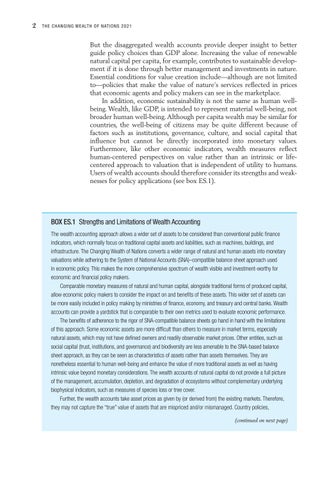2
T H E C H A N G I N G W E A LTH O F N ATIO N S 2021
But the disaggregated wealth accounts provide deeper insight to better guide policy choices than GDP alone. Increasing the value of renewable natural capital per capita, for example, contributes to sustainable development if it is done through better management and investments in nature. Essential conditions for value creation include—although are not limited to—policies that make the value of nature’s services reflected in prices that economic agents and policy makers can see in the marketplace. In addition, economic sustainability is not the same as human wellbeing. Wealth, like GDP, is intended to represent material well-being, not broader human well-being. Although per capita wealth may be similar for countries, the well-being of citizens may be quite different because of factors such as institutions, governance, culture, and social capital that influence but cannot be directly incorporated into monetary values. Furthermore, like other economic indicators, wealth measures reflect human-centered perspectives on value rather than an intrinsic or lifecentered approach to valuation that is independent of utility to humans. Users of wealth accounts should therefore consider its strengths and weaknesses for policy applications (see box ES.1).
BOX ES.1 Strengths and Limitations of Wealth Accounting The wealth accounting approach allows a wider set of assets to be considered than conventional public finance indicators, which normally focus on traditional capital assets and liabilities, such as machines, buildings, and infrastructure. The Changing Wealth of Nations converts a wider range of natural and human assets into monetary valuations while adhering to the System of National Accounts (SNA)–compatible balance sheet approach used in economic policy. This makes the more comprehensive spectrum of wealth visible and investment-worthy for economic and financial policy makers. Comparable monetary measures of natural and human capital, alongside traditional forms of produced capital, allow economic policy makers to consider the impact on and benefits of these assets. This wider set of assets can be more easily included in policy making by ministries of finance, economy, and treasury and central banks. Wealth accounts can provide a yardstick that is comparable to their own metrics used to evaluate economic performance. The benefits of adherence to the rigor of SNA-compatible balance sheets go hand in hand with the limitations of this approach. Some economic assets are more difficult than others to measure in market terms, especially natural assets, which may not have defined owners and readily observable market prices. Other entities, such as social capital (trust, institutions, and governance) and biodiversity are less amenable to the SNA-based balance sheet approach, as they can be seen as characteristics of assets rather than assets themselves. They are nonetheless essential to human well-being and enhance the value of more traditional assets as well as having intrinsic value beyond monetary considerations. The wealth accounts of natural capital do not provide a full picture of the management, accumulation, depletion, and degradation of ecosystems without complementary underlying biophysical indicators, such as measures of species loss or tree cover. Further, the wealth accounts take asset prices as given by (or derived from) the existing markets. Therefore, they may not capture the “true” value of assets that are mispriced and/or mismanaged. Country policies, (continued on next page)


